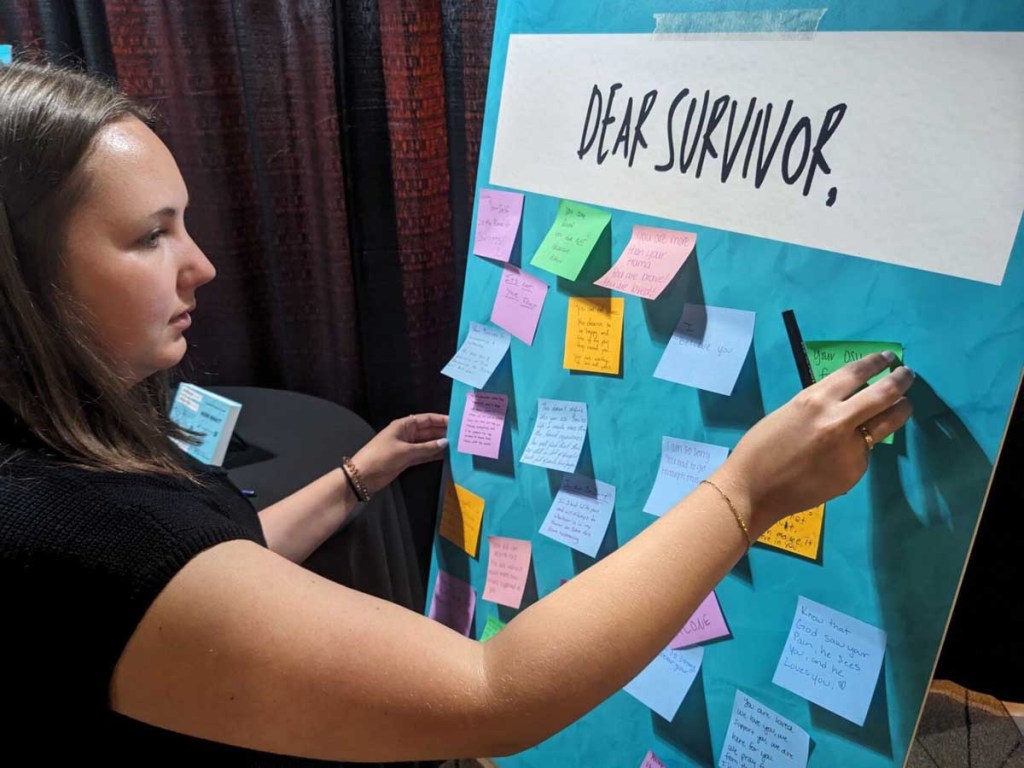‘What were you wearing?’ Student group promotes sexual violence prevention with thought-provoking exhibit
Published 7:12 am Saturday, April 27, 2024

- Claire Leffingwell, coordinator of Oklahoma State University’s 1 is 2 Many program, places a positive note of encouragement to survivors at the “What Were You Wearing?” exhibit in the Student Union basement.
STILLWATER, Oklahoma – The clothes themselves are ordinary. A purple T-shirt and gray gym shorts. A red blouse and a pair of jeans. An Oklahoma State University T-shirt and shorts.
But some are unexpected: a boy’s pajama set, a onesie and a long-sleeved sweater with a calf-length skirt.
These articles of clothing, and more like them, are displayed in the Student Union basement at this university in central Oklahoma, in an exhibit titled “What Were You Wearing?”
April is Sexual Assault Awareness Month, and the exhibit was from OSU’s 1 is 2 Many, a part of OSU’s prevention programming for sexual violence prevention on campus. The exhibit opened to the public Tuesday and will run through Friday during regular Student Union hours.
The display showcases real outfits and short stories of survivors of sexual assault, inviting members of the OSU community to reflect on victim-blaming beliefs and behaviors.
“A question that survivors might get asked a lot is, ‘What were they wearing?’” said Claire Leffingwell, coordinator of 1 is 2 Many. “Or sometimes it’s, ‘Have they had too much to drink?’ or ‘What were they doing that provoked a sexual assault?’”
Leffingwell said people often want to offer support to survivors but may ask questions that cause further damage.
“The point of the exhibit is to show there’s a variety of outfits, and none of them are what you would typically think of as a provocative outfit,” Leffingwell said. “They’re really just whatever people wear every day. We’re really trying to encourage students, faculty, staff and community members to think before they ask a survivor, ‘What were you wearing?’”
The Iowa Tribe of Oklahoma Victim Services Unit in Perkins partnered with 1 is 2 Many to present the exhibit. The tribe provided some of the outfits and 1 is 2 Many students put the other outfits together, based on OSU survivor student stories.
She said the team hasn’t done the exhibit in a few years, and it’s meant to be a passive, yet thought-provoking exhibit.
“We’re not really asking people super-hard questions,” Leffingwell said. “We’re not trying to get them to do an activity so much as we’re just trying to get people to take a pause in the middle of their everyday lives … to think about what are the beliefs and assumptions they have about survivors of sexual violence.”
At the end of the exhibit, visitors have a chance to say something positive to survivors using sticky notes, which they can place on a board reading “Dear Survivor.” Survivors can take the notes if they wish.
“Everyone knows somebody that has experienced it,” Leffingwell said. “A lot of the notes are, ‘You did nothing. This is not your fault.’”
Leffingwell said her team of volunteer students and other staff hold several outreach events each month on campus.
“We’re really trying to follow what students are doing and kind of capture that,” she said.
Those events include a spring break prevention party, where they focused on educating students on being healthy during spring break – including topics such as consumption of alcohol, consent and bystander intervention skills.
They also focused one event on safe partying practices. They offer workshops, promote healthy campaigns and facilitate discussions. Student groups joined them in hanging banners all month in the Student Union atrium supporting survivors of sexual violence.
The group also set aside Wednesday as “Denim Day,” where supporters from campus and the community could wear jeans in protest of a 1999 Italian Supreme Court case that overturned a rape conviction because the victim was wearing tight jeans. 1 is 2 Many promoted the day with giveaways on campus for those who helped “to dispel harmful myths about sexual violence and survivors” by wearing denim all day.





